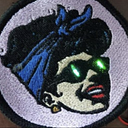Find your inspiration! This is Francois Kittenpaw, my soft, fine boi. My pet muse! If you want to create a scarf inspired by an animal you aren’t familiar with, look at a few pictures online to decide what characteristics your silly scarf will have.
I started on the head first. I drew a simple outline shape that wasn’t too big or too small, just enough to put a little stuffing inside. I planned, cut out, and placed the fleece details of Francois face I wanted to include.
I sewed the ear pieces on the face first, using a wide basted stitch, followed by a deocrative zig-zag stitch.
Then the eyes, nose and fluffy white chin!
Inserting the animal eyes into the fabric can be tricky. The easiest mistake to make is to cut the hole too large and the fabric doesn’t hold the eyeball securely.
Make the two outer sides face one another. Sew the edge about 1/4" inch from edge. Sew slowly and use a wide stitch type for the first pass. Some fleece is really stretchy, and you will need the seam to be strong if you plan on filling it with stuffing. To ensure your stitches are tight, go back over your first wide stitch with a smaller, tighter one.
After sewing most of the face shut, turn the face inside out so the edge seams are hidden. I like to use the end of a sharpie marker to poke out the stubborn seams that need coaxing , like the tips of the cat’s ears!
Stuffing time! Use smaller pieces to begin with, fill up the ears first. Take your time to ensure the fluff is evenly distributed. A lazily stuffed head will look lopsided! Use too much stuffing and your head could turn out heavy and too large to wear comfortably.
I cut out a long fleece rectangle and folded it in half. I eyeballed my measurements at first and opted to go for a longer scarf over a shorter one for my first try. The exact width and length is up to you, depending on if you want a thin short scarf, or a chunky fat one. You might measure a scarf you currently own to compare and determine your perfect scarf length. I cut out a paper paw to roughly trace around.
I sewed the folded in half rectangle together along the long side seam. Then I laid it flat and lined up the edge like shown above. I planned on hiding the seam on the belly of the cat, so the paws would be on either side of the seam. I cut away a small arch, and used the cut away pieces as a pattern for my other side.
I sewed the back feet seams with a more rectangular shape, and made the front paws appear more rounded. The back feet are sewn completely shut, the front feet I left a section unsewn so that I could put stuffing into the paws. I realized later that I had to rip a few stitches between the back feet so I could insert the cat’s tail.
The paw seams were sloppy and a little wonky. It definitely shows when the stuffing is inside. I used hot glue to press the raw edges closed between the two front paws.
I hot glued the head on, adding extra so the head would face upwards and not flop down with the weight of itself.
Here you can see where I stuffed in the tail between the back feet. I safety pinned it first and tried it on before hot gluing the tail firmly into the ripped seam.
The finishing touches were some gray fleece stripes I lazily secured with hot glue. The I hand cut the stripes and adhered them all the way to the tail.
The end result was cute and functional. Good luck on your own fabulous animal scarf!
